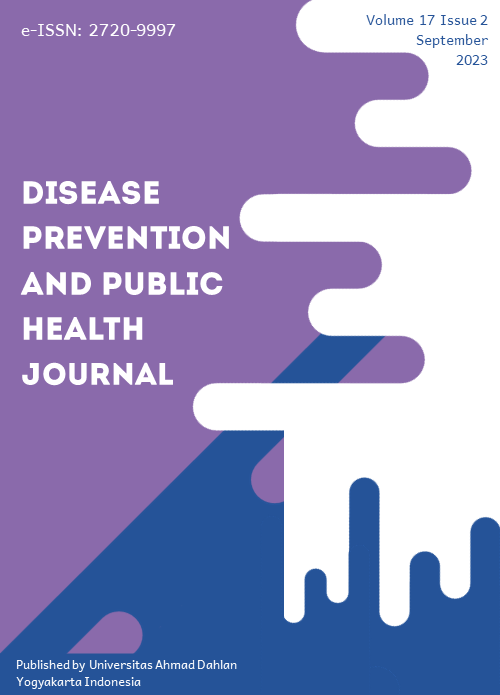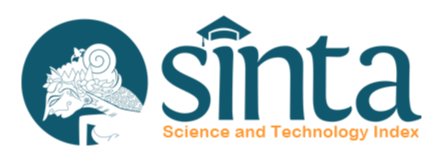Substitution of Durian Seed Flour and Butterfly Pea Flower Extra in Donuts as Children's Healthy Snack
DOI:
https://doi.org/10.12928/dpphj.v17i2.8454Keywords:
Durian Seed Flour, Butterfly Pea Flower Extra, Donuts, Healthy SnackAbstract
Background: Snacks, of course, cannot be separated from human life, especially for children who are growing up. Technological developments have made local food commodities utilize waste durian seeds and use butterfly pea flowers. Durian seed flour and butterfly pea flower have good nutritional content for children's food. Method: This study is an experimental study with a Completely Randomized Design (CRD) with two treatments. (Treatment A) 170 grams of wheat flour + 30 grams of durian seed flour + butterfly pea flower extract, (Treatment B) 140 grams of wheat flour + 60 grams of durian seed flour + butterfly pea flower extract. The organoleptic test assessment was carried out by 25 untrained panelist subjects who were carried out at the Mandiri College Elementary School, Siombak, Medan Marelan. Results: From the above results we can see that treatment A with the addition of 30 grams of durian seed flour and extra butterfly pea flowers was the most preferred in terms of aroma, texture, color, and taste. The color category has a very fond interest with a value of 4.04, the aroma category has a liking interest with a value of 3.96, the texture category has a very fond interest with a value of 4.08, the taste category has a very like interest with a value of 4.28. Conclusion: Substituting durian seed flour and extra butterfly pea flowers for donuts can be another solution for healthy snacks for elementary school children.
References
Kapusta J, Drlik M, Munk M. Using of n-grams from morphological tags for fake news classification. PeerJ Comput Sci. 2021 Jul 19;7:e624. doi: 10.7717/peerj-cs.624. PMID: 34395862; PMCID: PMC8323729.
Charoenkiatkul, S., Thiyajai, P., & Judprasong, K. (2016). Nutrients and bioactive compounds in popular and indigenous durian (Durio zibethinus murr.). Food Chemistry, 193, 181–186. doi: https://doi.org/10.1016/j.foodchem.2015.02.107
Alappat B, Alappat J. Anthocyanin Pigments: Beyond Aesthetics. Molecules. 2020 Nov 24;25(23):5500. doi: 10.3390/molecules25235500. PMID: 33255297; PMCID: PMC7727665.
Escher GB, Wen M, Zhang L, Rosso ND, Granato D. Phenolic composition by UHPLC-Q-TOF-MS/MS and stability of anthocyanins from Clitoria ternatea L. (butterfly pea) blue petals. Food Chem. 2020 Nov 30;331:127341. doi: 10.1016/j.foodchem.2020.127341. Epub 2020 Jun 15. PMID: 32569972.
Radoš K, Čukelj Mustač N, Varga K, Drakula S, Voučko B, Ćurić D, Novotni D. Development of High-Fibre and Low-FODMAP Crackers. Foods. 2022 Aug 25;11(17):2577. doi: 10.3390/foods11172577. PMID: 36076763; PMCID: PMC9455160.
Husin, N. A., Rahman, S., Karunakaran, R., & Bhore, S. J. (2018). Open access A review on the nutritional , medicinal , molecular and genome attributes of Durian ( Durio zibethinus L .), the King of fruits in Malaysia. 14(6), 265–270. https://doi.org/10.6026/97320630014265
Tzompa-Sosa DA, Provijn P, Gellynck X, Schouteten JJ. Frying dough with yellow mealworm oil: Aroma profile and consumer perception at a central location test and at home. J Food Sci. 2023 Mar;88(S1):130-146. doi: 10.1111/1750-3841.16389. Epub 2022 Dec 8. PMID: 36478571.
Morris JB. Multivariate Analysis of Butterfly Pea (Clitoria ternatea L.) Genotypes With Potentially Healthy Nutraceuticals and Uses. J Diet Suppl. 2023;20(3):475-484. doi: 10.1080/19390211.2021.2022821. Epub 2022 Jan 7. PMID: 34996311.
Rossi MJ, Brand JC. Journal Article Titles Impact Their Citation Rates. Arthroscopy. 2020 Jul;36(7):2025-2029. doi: 10.1016/j.arthro.2020.02.018. Epub 2020 Feb 26. PMID: 32109575.
Prodromidis P, Mourtzinos I, Biliaderis CG, Moschakis T. Stability of natural food colorants derived from onion leaf wastes. Food Chem. 2022 Aug 30;386:132750. doi: 10.1016/j.foodchem.2022.132750. Epub 2022 Mar 19. PMID: 35367800.
Jeyaraj EJ, Lim YY, Choo WS. Extraction methods of butterfly pea (Clitoria ternatea) flower and biological activities of its phytochemicals. J Food Sci Technol. 2021 Jun;58(6):2054-2067. doi: 10.1007/s13197-020-04745-3. Epub 2020 Sep 1. PMID: 33967304; PMCID: PMC8076379.
Gutierrez-Castillo C, Alcázar-Alay S, Vidaurre-Ruiz J, Correa MJ, Cabezas DM, Repo-Carrasco-Valencia R, Encina-Zelada CR. Effect of partial substitution of wheat flour by quinoa (Chenopodium quinoa Willd.) and tarwi (Lupinus mutabilis Sweet) flours on dough and bread quality. Food Sci Technol Int. 2022 Jun 7:10820132221106332. doi: 10.1177/10820132221106332. Epub ahead of print. PMID: 35673705.
Loa M, Hidayanty H, Arifuddin S, Ahmad M, Hadju V. Moringa oleifera leaf flour biscuits increase the index of erythrocytes in pregnant women with anemia. Gac Sanit. 2021;35 Suppl 2:S206-S210. doi: 10.1016/j.gaceta.2021.10.022. PMID: 34929813.
Charoenphun N, Klangbud WK. Antioxidant and anti-inflammatory activities of durian (Durio zibethinus Murr.) pulp, seed and peel flour. PeerJ. 2022 Feb 7;10:e12933. doi: 10.7717/peerj.12933. PMID: 35186500; PMCID: PMC8830296.
Ning Chen W. A novel biosustainable durian antimicrobial gel dressing. J Wound Care. 2021 May 2;30(5):330. doi: 10.12968/jowc.2021.30.5.330. PMID: 33979217.
Oguis GK, Gilding EK, Jackson MA, Craik DJ. Butterfly Pea (Clitoria ternatea), a Cyclotide-Bearing Plant With Applications in Agriculture and Medicine. Front Plant Sci. 2019 May 28;10:645. doi: 10.3389/fpls.2019.00645. PMID: 31191573; PMCID: PMC6546959.
Singh R, Yu CC, Chen GW, Chen CH, Sinaki NY, Lin J, Koksel F. Butterfly Pea Flower as a Novel Ingredient to Produce Antioxidant-Enriched Yellow Pea-Based Breakfast Cereals. Foods. 2022 Oct 30;11(21):3447. doi: 10.3390/foods11213447. PMID: 36360061; PMCID: PMC9657694.
Colley P, Miller L, Seabrook JA, Woodruff SJ, Gilliland J. Children's perceptions of a Centrally Procured School Food Program in southwestern Ontario, Canada. Health Promot Chronic Dis Prev Can. 2021 Apr;41(4):131-137. doi: 10.24095/hpcdp.41.4.02. PMID: 33851812; PMCID: PMC8128028.
Bleiweiss-Sande R, Chui K, Wright C, Amin S, Anzman-Frasca S, Sacheck JM. Associations between Food Group Intake, Cognition, and Academic Achievement in Elementary Schoolchildren. Nutrients. 2019 Nov 9;11(11):2722. doi: 10.3390/nu11112722. PMID: 31717571; PMCID: PMC6893423.
Thuy NM, Minh VQ, Ben TC, Thi Nguyen MT, Ha HTN, Tai NV. Identification of Anthocyanin Compounds in Butterfly Pea Flowers (Clitoria ternatea L.) by Ultra Performance Liquid Chromatography/Ultraviolet Coupled to Mass Spectrometry. Molecules. 2021 Jul 27;26(15):4539. doi: 10.3390/molecules26154539. PMID: 34361692; PMCID: PMC8348707.
da Cunha JA, Rolim PM, Damasceno KSFDSC, de Sousa Júnior FC, Nabas RC, Seabra LMJ. From seed to flour: Sowing sustainability in the use of cantaloupe melon residue (Cucumis melo L. var. reticulatus). PLoS One. 2020 Jan 2;15(1):e0219229. doi: 10.1371/journal.pone.0219229. PMID: 31895921; PMCID: PMC6939897.
Sung WC, Chiu ET, Sun A, Hsiao HI. Incorporation of chia seed flour into gluten-free rice layer cake: Effects on nutritional quality and physicochemical properties. J Food Sci. 2020 Mar;85(3):545-555. doi: 10.1111/1750-3841.14841. Epub 2020 Jan 30. PMID: 31999371.
Lu H, Guo L, Zhang L, Xie C, Li W, Gu B, Li K. Study on quality characteristics of cassava flour and cassava flour short biscuits. Food Sci Nutr. 2019 Dec 13;8(1):521-533. doi: 10.1002/fsn3.1334. PMID: 31993176; PMCID: PMC6977506.
Roger P, Bertrand BMM, Gaston Z, Nouhman B, Elie F. Nutritional Composition of Biscuits from Wheat-Sweet Potato-Soybean Composite Flour. Int J Food Sci. 2022 Jun 9;2022:7274193. doi: 10.1155/2022/7274193. PMID: 35720433; PMCID: PMC9203213.
Barreca D, Nabavi SM, Sureda A, Rasekhian M, Raciti R, Silva AS, Annunziata G, Arnone A, Tenore GC, Süntar İ, Mandalari G. Almonds (Prunus Dulcis Mill. D. A. Webb): A Source of Nutrients and Health-Promoting Compounds. Nutrients. 2020 Mar 1;12(3):672. doi: 10.3390/nu12030672. PMID: 32121549; PMCID: PMC7146189.
Paudel D, Dhungana B, Caffe M, Krishnan P. A Review of Health-Beneficial Properties of Oats. Foods. 2021 Oct 26;10(11):2591. doi: 10.3390/foods10112591. PMID: 34828872; PMCID: PMC8625765.
Michalak M, Pierzak M, Kręcisz B, Suliga E. Bioactive Compounds for Skin Health: A Review. Nutrients. 2021 Jan 12;13(1):203. doi: 10.3390/nu13010203. PMID: 33445474; PMCID: PMC7827176.
Vella FM, Cautela D, Laratta B. Characterization of Polyphenolic Compounds in Cantaloupe Melon By-Products. Foods. 2019 Jun 6;8(6):196. doi: 10.3390/foods8060196. PMID: 31174393; PMCID: PMC6617032.
Selaledi L, Mbajiorgu CA, Mabelebele M. The use of yellow mealworm (T. molitor) as alternative source of protein in poultry diets: a review. Trop Anim Health Prod. 2020 Jan;52(1):7-16. doi: 10.1007/s11250-019-02033-7. Epub 2019 Aug 7. PMID: 31392553.
Thrastardottir R, Olafsdottir HT, Thorarinsdottir RI. Yellow Mealworm and Black Soldier Fly Larvae for Feed and Food Production in Europe, with Emphasis on Iceland. Foods. 2021 Nov 9;10(11):2744. doi: 10.3390/foods10112744. PMID: 34829029; PMCID: PMC8625742.
Downloads
Published
Issue
Section
License
Copyright (c) 2023 Universitas Ahmad Dahlan

This work is licensed under a Creative Commons Attribution-ShareAlike 4.0 International License.
Authors transfer the copyright and grant the Disease Prevention and Public Health Journal right of first publication with the work simultaneously licensed under a Creative Commons Attribution License (CC BY-SA 4.0) that allows others to share (copy and redistribute the material in any medium or format) and adapt (remix, transform, and build upon the material) the work for any purpose, even commercially with an acknowledgement of the work's authorship and initial publication in Disease Prevention and Public Health Journal. Authors are able to enter into separate, additional contractual arrangements for the non-exclusive distribution of the journal's published version of the work (e.g., post it to an institutional repository or publish it in a book), with an acknowledgement of its initial publication in Disease Prevention and Public Health Journal. Authors are permitted and encouraged to post their work online (e.g., in institutional repositories or on their website) prior to and during the submission process, as it can lead to productive exchanges, as well as earlier and greater citation of published work (See The Effect of Open Access).

This work is licensed under a Creative Commons Attribution-ShareAlike 4.0 International License.







